Calculadoras gratuitas paso por paso para álgebra, Trigonometría y cálculoStack Exchange network consists of 176 Q&A communities including Stack Overflow, the largest, most trusted online community for developers to learn, share their knowledge, and build their careers Visit Stack ExchangeFind the derivative of f(x) = sec 2x Select one f'(x) = 3 sec3 2x tan 2x B f'(x) = 6 sec3 2x tan 2x C f'(x) = 6 sec2 2x D

Find The Derivatives Of The Following Sec X
Derivative of sec^2x tan x
Derivative of sec^2x tan x-Proof derivative of tanx = sec^2x $\begingroup$ You do get $2\sec^2x\tan x$ !




Derivative Of Tan 2x 3 From First Principle Brainly In
Find the Derivative d/dx y=2sec(x)tan(x) Since is constant with respect to , the derivative of with respect to is Differentiate using the Product Rule which states that is where and The derivative of with respect to is Multiply by by adding the exponents From above, we found that the first derivative of sec^2x = 2sec 2 (x)tan(x) So to find the second derivative of sec^2x, we need to differentiate 2sec 2 (x)tan(x) We can use the product and chain rules, and then simplify to find the derivative of 2sec 2 (x)tan(x) is 4sec 2 (x)tan 2 (x) 2sec 4 (x)This proves from first principles that the derivative of tan x is sec^2x Approved by eNotes Editorial Team We'll help your grades soar Start your 48hour free trial and unlock all the
Integration goes the other way the integral (or antiderivative) of 1 / x should be a function whose derivative is 1 / x\( \frac{d}{dx} {tanx} = \frac{d}{dx} \frac{sinx}{cosx}\) we know that \( tanx =\frac{sinx}{cosx If we zone in on − π 2 ≤ x ≤ π 2, then we see that the value of sec 2 ( x) is greater as we approach x = − π 2 or x = π 2 This is because we can think of the derivative as slope and previously saw that the slope was greatest near the asymptotes Therefore, it is natural for sec 2
Just for practice, I tried to derive d/dx (tanx) using the product rule It took me a while, because I kept getting to (1sin^2 (x))/cos^2 (x), which evaluates to sec^2 (x) tan^2 (x) Almost there, but not quite After a lot of fiddling, I got the correct result by adding cos^2 (x) toThe derivative of tan x, sec x & tan x – The derivative of a function of a real variable measures the sensitivity to change of the function value (output value) with respect to a change in its argument (input value) Derivatives are a fundamental tool of calculus For example, the derivative of the position of a moving object with respect to time is the object's velocity this measures howI prefer to write sin x tan x as (sin x)^2 / cos x = 1/cos x (cos x)^2 / cos x = sec x cos x simply differentiate to get y' = sec x tan x sin x = (sin x) ( (sec x)^2 1) = sin x ((tan x)^2 2) in terms of our original variables Extra c




Find The Derivatives Of The Following Sec X
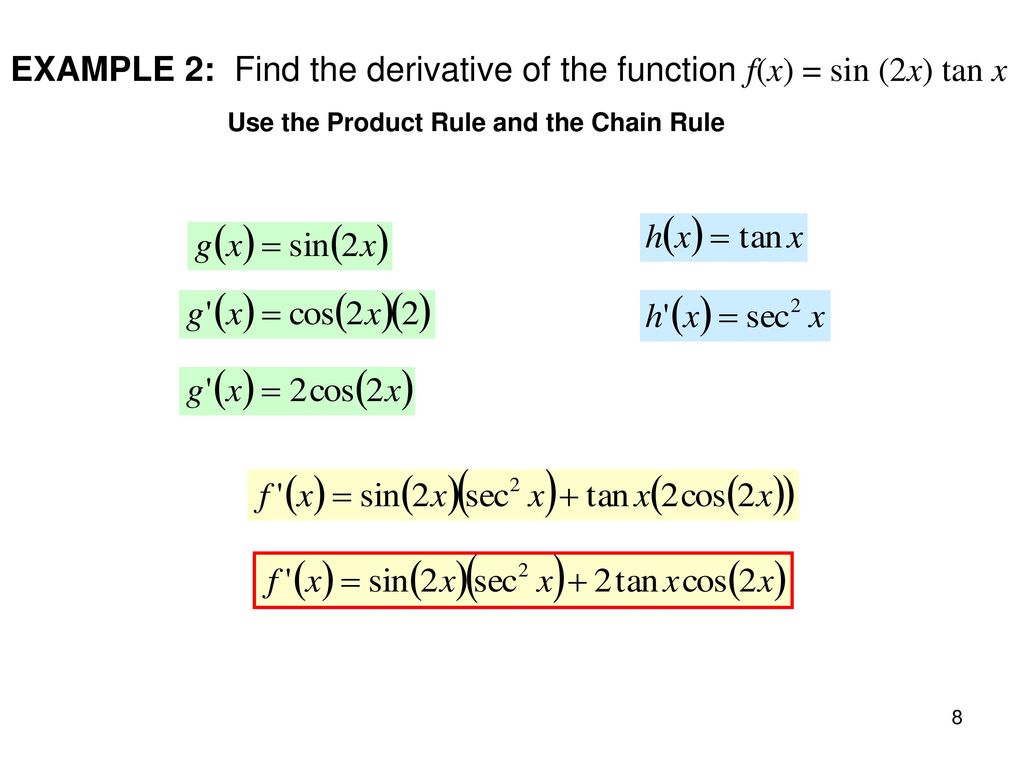



Derivatives Of Trigonometric Functions Ppt Download
Dy/dx is nothing but the rate of change of y with respect to the change in the value of x ie if ∆x is a very small change in the value of x ,the corresponding change in the value of y is ∆y, then dy/dx = limit ∆x tends to 0 ∆y/∆x iedy/dx = limitIf the derivative of a is b, then the integral of b is a C, where C is a constant This tells us that to check our work, we can take the integral of 2sec 2 x tan x, and we should get sec 2 x Transcribed image text Question 8 Find the derivative of f(x) =e4x sec2x Oa f'(x) =4 e4x sec 2x 2 e4x sec 2x tan 2x Obf'(x) = e46 sec 2X – 24x sec 2x tan 2x Ocf'(x)=4 e 4x sec 2x e4x sec 2x tan 2x Odf'(x) =4 e 4x sec 2x – 2 e4x sec 2x tan
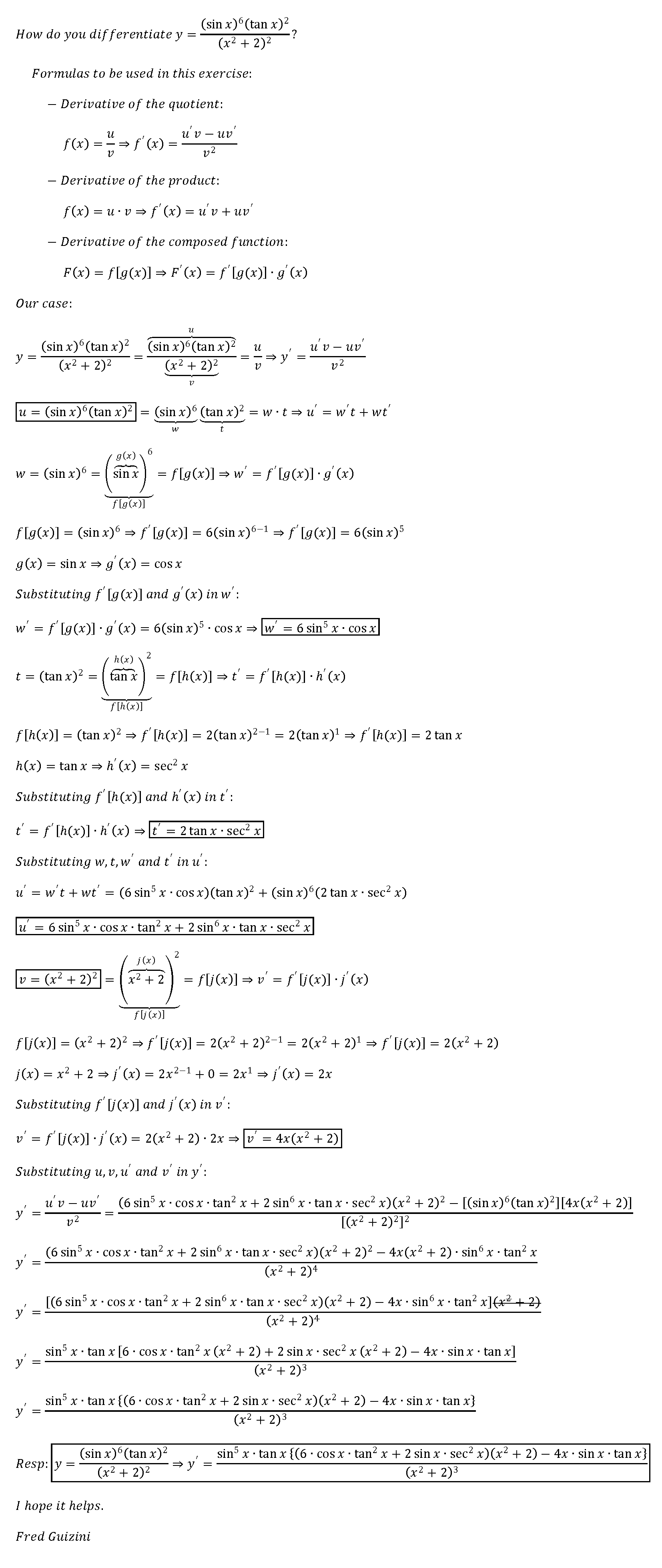



How Do You Differentiate Y Sin X 6 Tan X 2 X 2 2 2 Socratic




Derivatives Of Trig Functions
The derivative of sec2 (x) is 2sectwo (x) tan (x) The chain rule says the derivative of f (g (x)) is equivalent to Derivative Proofs d/dx tan (x)=sec^2 (x) Watch later Share Copy link Info Shopping Tap to unmute If playback doesn't begin shortly, try restarting your device Up next in 8Calculus Find the Derivative d/dx y = square root of tan (x) y = √tan (x) y = tan ( x) Rewrite √tan(x) tan ( x) as tan(x)1 2 tan ( x) 1 2 d dx tan(x)1 2 d d x tan ( x) 1 2 Differentiate using the chain rule, which states that d dx f (g(x)) d d x f ( g ( x)) is f '(g(x))g'(x) f ′ ( g ( x)) g ′ ( x) where f (x) = x1 2 f ( x



Canvas Dartmouth Edu Courses Files Download Verifier Rmxgcneperjdvjlkenjssvgaozswtub3esrovsbi Wrap 1



1
The Derivative of h (x) = 2*sec^2 (x)*tan (x) Product Rule Example Watch later The derivative of the function secant squared of x is d/dx(sec^2(x)) = 2sec^2(x)tan(x) This derivative is obtained by applying the chain rule of differentiation and simplifying the result Sec^2(x) is a composite function that can be rewritten as (sec(x))^2In a previous video we use the quotient rule in order to find the derivatives of tangent of X and cotangent of X and what I want to do in this video is to keep going and find the derivatives of secant of X and cosecant of X so let's start with secant of X the derivative with respect to X of secant of X well secant of X is the same thing as so we're going to find the derivative with



Http Www Nd Edu Math Lecture notes 10 26 notes Pdf



2
Derivative Calculator Derivative of 2*sec (x)^2*tan (x) by x = 4*sec (x)^2*tan (x)^22*sec (x)^4 Show a step by step solution Draw graph Edit expression Direct link to this page Value at x= Derivative Calculator computes derivatives of a function with respect to given variable using analytical differentiation and displays a stepbystep solutionFind the Derivative d/dx y=(sec(x))/x Differentiate using the Quotient Rule which states that is where and The derivative of with respect to is Differentiate using the Power RuleFree math problem solver answers your algebra, geometry, trigonometry, calculus, and statistics homework questions with stepbystep explanations, just like a math tutor



Derivative Of Tanx By First Principle Video Dailymotion




Quiz Worksheet Practice Differentiating Squared Trig Functions Study Com
Math\large\boxed{Given ~that ~y=tanxsecx,Now,differentiating~both~sides~wrt~x,~we~get~\dfrac{dy}{dx}=\sec^2(x)\sec(x)\cdot \tan(x)=\sec(x)\sec(x)\tan(xFree derivative calculator differentiate functions with all the steps Type in any function derivative to get the solution, steps and graph This website uses cookies to ensure you get the best experienceDerivative of \(tanx = sec^2x \) What Is The Derivative Of tan(x)?
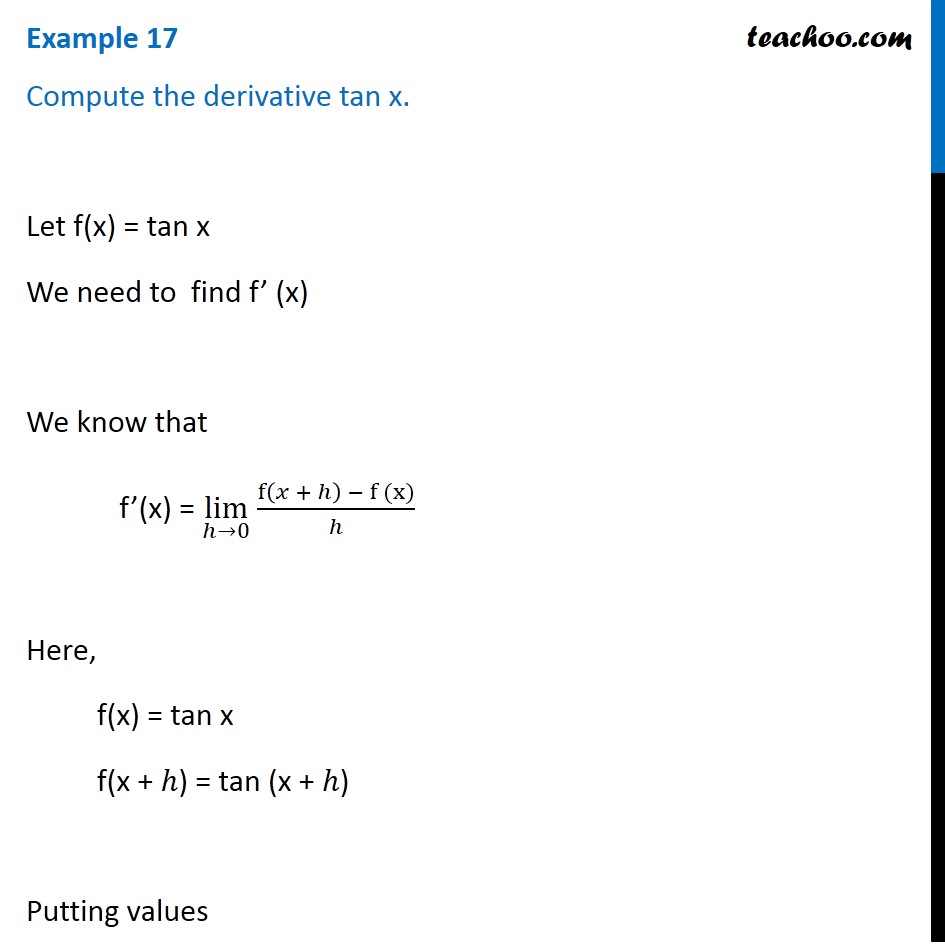



Prove That Derivative Of Tan X Is Sec 2 X By First Principle




Sample Problems Cos 2 X Tan2 X Tan 2 Csc 2 Tan Sec X Tan X Cos X Sin 4 X Cos 4 X 1 2 Cos 2 X Pdf Free Download
Answer to Find derivative of log sec x tan x By signing up, you'll get thousands of stepbystep solutions to your homework questions YouThen du/dv u*v= u'vuv' where u' is derivative of u and v' is derivative of v now du/dv u*v= derivative of sec x * tanx derivative of tanx * sec x Now its equal toIn this video "Derivative or differentiation differentiating of Tan(x) from First Principles Proof" we will prove that the derivative of Tan(x) is Sec^(x) by




Range Of The Function F X Sec 2x Tanx Sec 2x Tanx 2ltxlt 2 I




Derivative Of Tan X By Yatendra Parashar Issuu
In doing this, the Derivative Calculator has to respect the order of operations A specialty in mathematical expressions is that the multiplication sign can be left out sometimes, for example we write "5x" instead of "5*x" The Derivative Calculator has to detect these cases and insert the multiplication sign `d/(dx)tan x=sec^2x` Using the Product Rule and Properties of tan x, we have `(dy)/(dx)` `= ` `tan x 3(cos x)^2(sin x)>` `=(cos^3x)/(cos^2x)` `(sin x)/(cos x) 3(cos x)^2(sin x)>` `=cos x3 sin^2x cos x` We must recognize if this expression creates a true statement once we substitute it right into the LHS of the equation offered in the question Use the derivatives of trig functions and the chain rule d dx (sec(2x)) = sec(2x)tan(2x) ⋅ 2 = 2sec(2x)tan(2x) d dx (tan(2x)) = sec2(2x) ⋅ 2 = 2sec2(2x)




Worked Example Derivative Of Sec 3p 2 X Using The Chain Rule Video Khan Academy




Proof That The Derivative Of Tan X Sec 2x Using The Quotient Rule Album On Imgur
Unlock StepbyStep derivative of sec^2 (x) Extended Keyboard Examples By realising that tan^2(x)=sec^2(x) 1, the integration of these two terms evaluates to tan(x) x What is the integral of x 1?It is not true that tan x = sec2 x However,




Ex 7 6 24 Integrate E X Sec X 1 Tan X Dx Is A E X Cos X
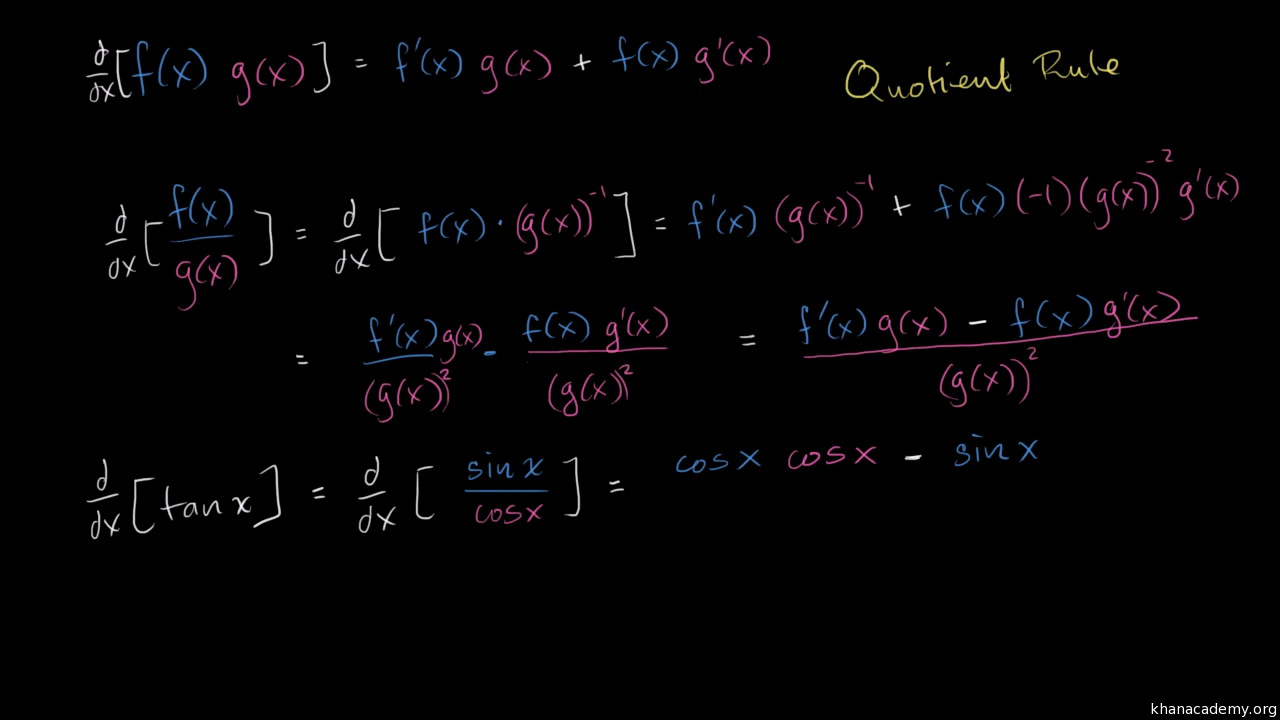



Derivative Of Tan X Old Video Khan Academy
$\endgroup$ – Yves Daoust Feb 13 at 1654 $\begingroup$ haha yeah I just simplified it totally wrong Thanku )Math\int sec(x)tan(x) dx/math mathsec(x)=\frac{1}{cos(x)}, tan(x)=\frac{sin(x)}{cos(x)}/math mathsec(x)tan(x)=\frac{sin(x)}{cos^2(x)}/math math\int Using the chain rule, the derivative of sec (2x) is 2sec (2x)tan (2x) Finally, just a note on syntax and notation sec (2x) is sometimes written in the forms below (with the derivative as per the calculation above) Just be aware that not all of the forms below are mathematically correct The Second Derivative Of sec (2x)



1



2
If u = tan x 2then du = sec x dx and tan x sec 2 x dx = u du = 1 u2 c 2 = 1 tan2 x c 2 b) Compute tan x sec 2 x dx by substituting v = sec x If v = sec x then dv = sec x tan x dx and tan x sec 2 x dx = sec x(tan x sec x dx) = v dv = 1 v 2 C 2 = 1 sec 2 x C 2 c) Compare the two results At first glance you may 2think you made a mistake; y = sec^2(x) tan^2(x), Find the derivative of the functionFind the AntiDerivative sec(x)*tan(x) Write the polynomial as a function of The function can be found by finding the indefinite integral of the derivative Set up the integral to solve Since the derivative of is , the integral of is The answer is the antiderivative of the function



2



Www Tamdistrict Org Cms Lib Ca Centricity Domain 348 27 sept 18 worksheet derviatives Pdf
6 Find the derivative of the function r(e) (cote) 7 Find f'(x) it f(x) 3 D 2 In 3 sec 2x tan 2x3E 2In 3 sec 2x tan 2x s Soppose fis a differentiable function for all real sumbers, and g is the inverse of f 9, lf 8xU3 yas = 41, find the rate uf change ofy with respect tn x wlenz " 64 and y 27 10 The derivative of sec x tan x In simple language, keep the initial term as it is and distinguish the second term, then distinguish the first term and keep the next term since it is or viceversa What is the derivative of SEC 2x?Prove that the derivative of tan (x) is sec^2 (x) Let y = tan (x) Recall the definition of tan (x) as sin (x)/cos (x) Therefore y = sin (x)/cos (x) Use the quotient rule, which states that for y = f (x)/g (x), dy/dx = (f' (x)g (x) f (x)g' (x))/g 2 (x) with f (x) = sin (x) and g (x) = cos (x) Recall the derivatives of sin (x) as cos (x) and




Derivative Of Tan 2x 3 From First Principle Brainly In




Solved The Second Derivative Of Y Tan 2 X Is A Y 2 Chegg Com
In a similar way, the derivative of sec(2x) with respect to 2x is sec(2x)tan(2x) We will use this fact as part of the chain rule to find the derivative of sec(2x) with respect to x How to find the derivative of sec(2x) using the Chain Rule To find the second derivative, we will have to use the product rule f ''(x) = 2tanx d dx (sec2x) 2sec2x d dx (tanx) Note that we already know that d dx (sec2x) = 2sec2xtanx and that d dx (tanx) = sec2x Example 17 Compute the derivative tan x Let f(x) = tan x We need to find f' (x) We know that f'(x) = lim┬(ℎ→0) f〖(𝑥 ℎ) − f (x)〗/ℎ Here, f(x) = tan x f(x ℎ) = tan (x ℎ) Putting values f' (x) = lim┬(ℎ→0) tan〖(𝑥 ℎ) −tan𝑥 〗/ℎ = lim┬(ℎ→0) 1/ℎ ( tan (x




Integral Of Sec 2 X Sqrt 1 Tan 2 X Using The Arcsine Function Youtube



Http Smacmathapcalculus Weebly Com Uploads 1 9 2 5 Fc Unit 3 5 Hw Key Mistake On Test Prep 4v2 Pdf
(tan x)' = sec^2 x Let f(x) = tanx We know that tanx = sinx/ cosx ==> f(x) = sinx/ cosx Now to differenctiate f(x) we will use the chain rule f(x) = u/v such that u= sinx ==> u' = cosx
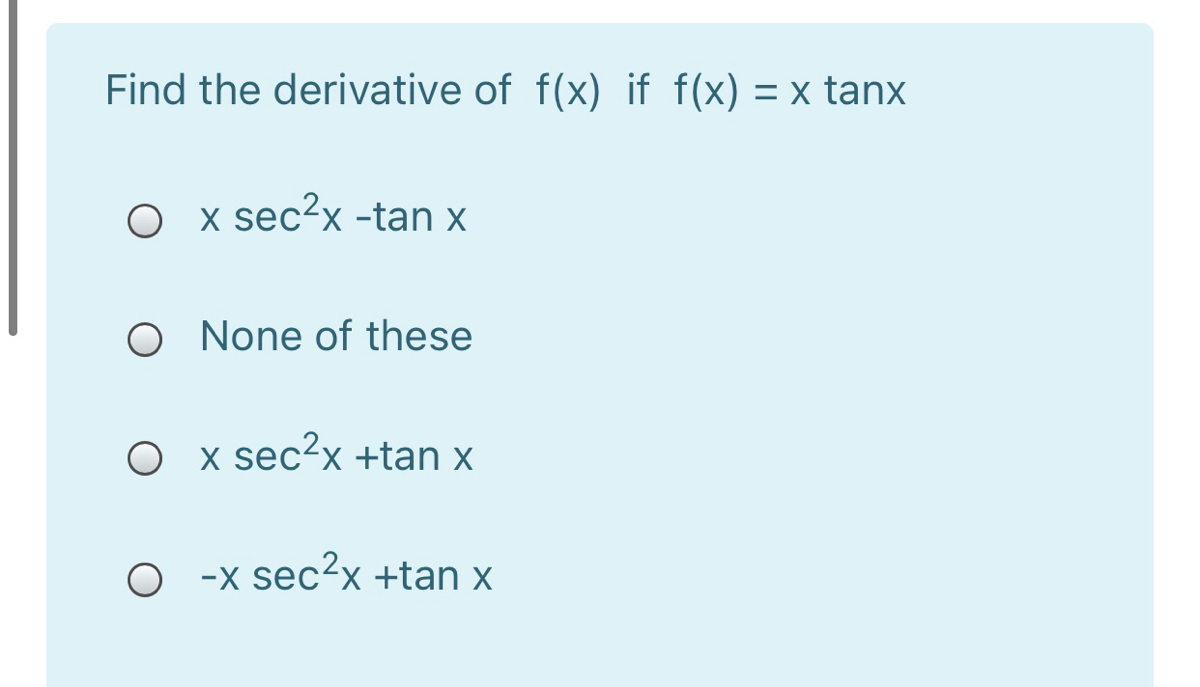



Answered Find The Derivative Of F X If F X X Bartleby



Solved Question 13 1 Point Dy Determine The Derivative For Gt Titan 9 Tan 2x 9 Obj 7 x 90 Tan 2x 9 O C Sec 2x Course Hero




Solution Differentiate Y Sec X 2 2



Yorkshiremathstutor Com Wp Content Uploads 19 02 8 Differentiation Answers Pdf




Powers Of Trigonometric Functions




Solved The Second Derivative Of Y Tan 2 X Is A Y 2 Chegg Com



2




Limit Trigonometric Function 2 Sec 2x 1 Tan X Youtube




The Derivative Of H X 2 Sec 2 X Tan X Product Rule Example Youtube
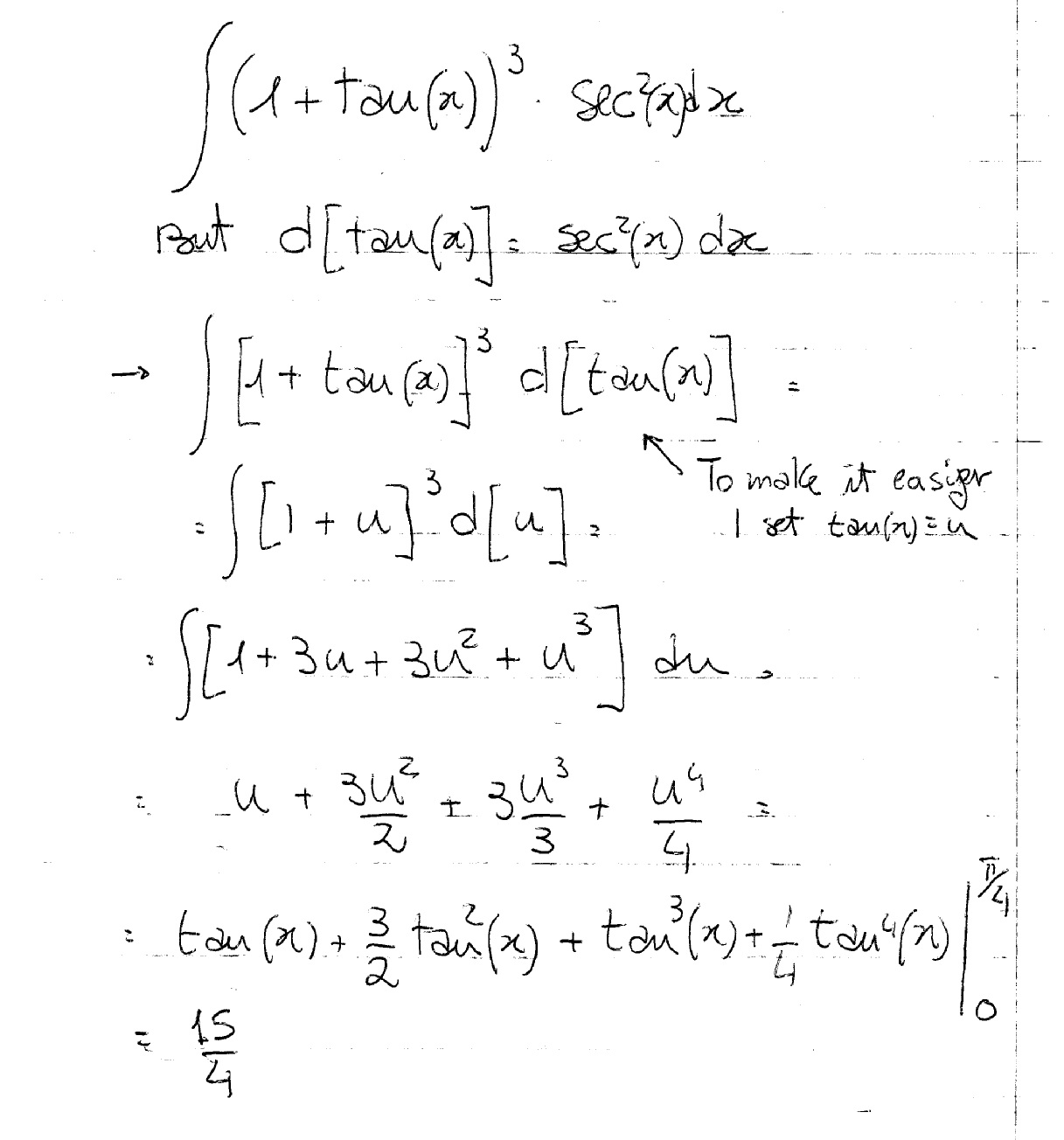



How Do You Evaluate The Integral 1 Tan X 3 Sec 2 X Dx Within The Range 0 Pi 4 Socratic



3




The Derivative Of Tan X Is Sec 2 X Why Mathematics Stack Exchange



Solved If F X 2x 2tanx Secx If F 5 Course Hero




Derivative Of Sec 3 2x
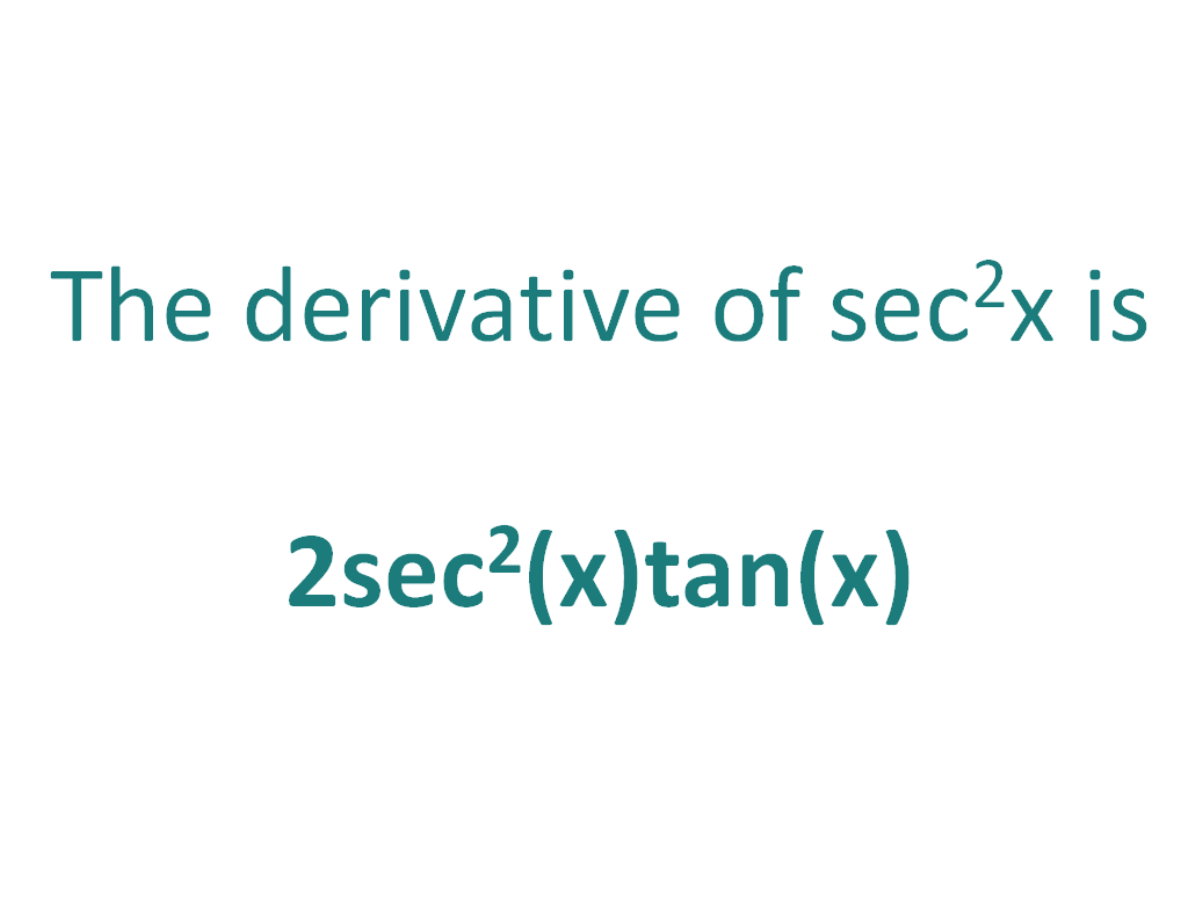



The Derivative Of Sec 2x Derivativeit



Www Mesacc Edu Scotz Mat2 Notes Differentiation Random Derivatives Part 2 Pdf



2
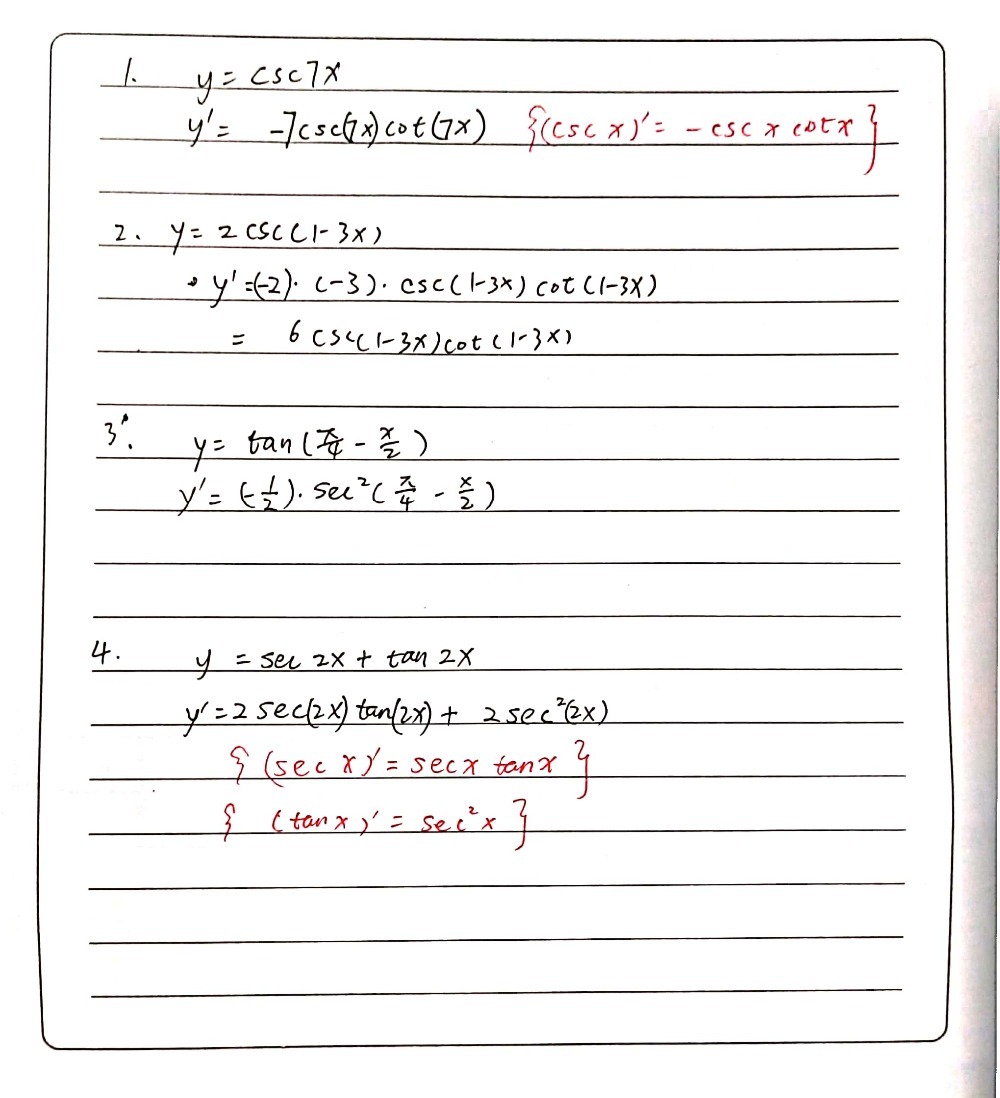



Find The Derivative Of The Following Functions 1 Gauthmath



Http Math Hws Edu Mitchell Math130f16 Practest2 Pdf



What Is The Second Derivative Of Tanx Secx Quora




Integration Calculus Notes
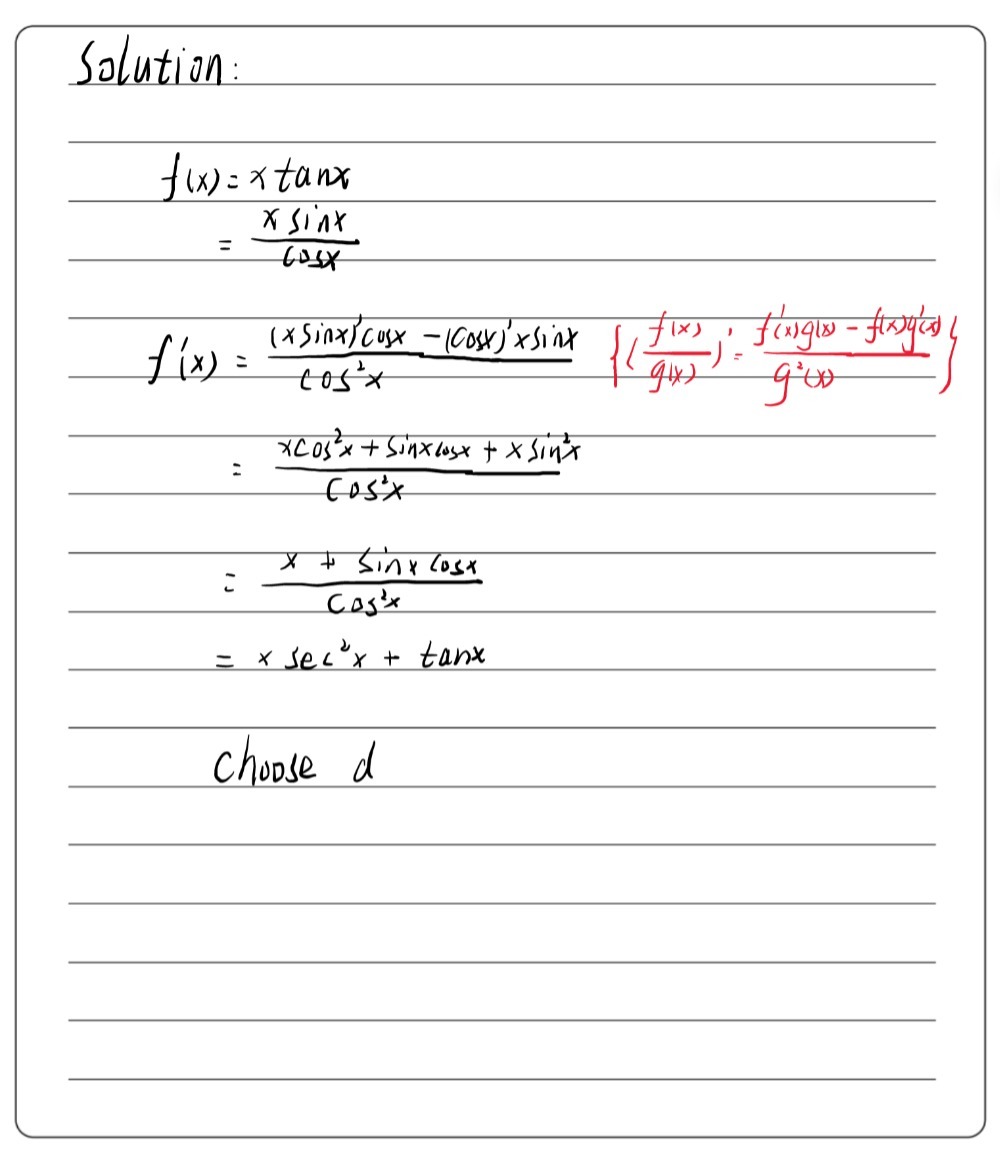



21 What Is The Derivative Of Fx Xtan X A 1 S Gauthmath




Integration Of Tan 2 X Sec 2 X Youtube




Derivative Of Sec 3 2x
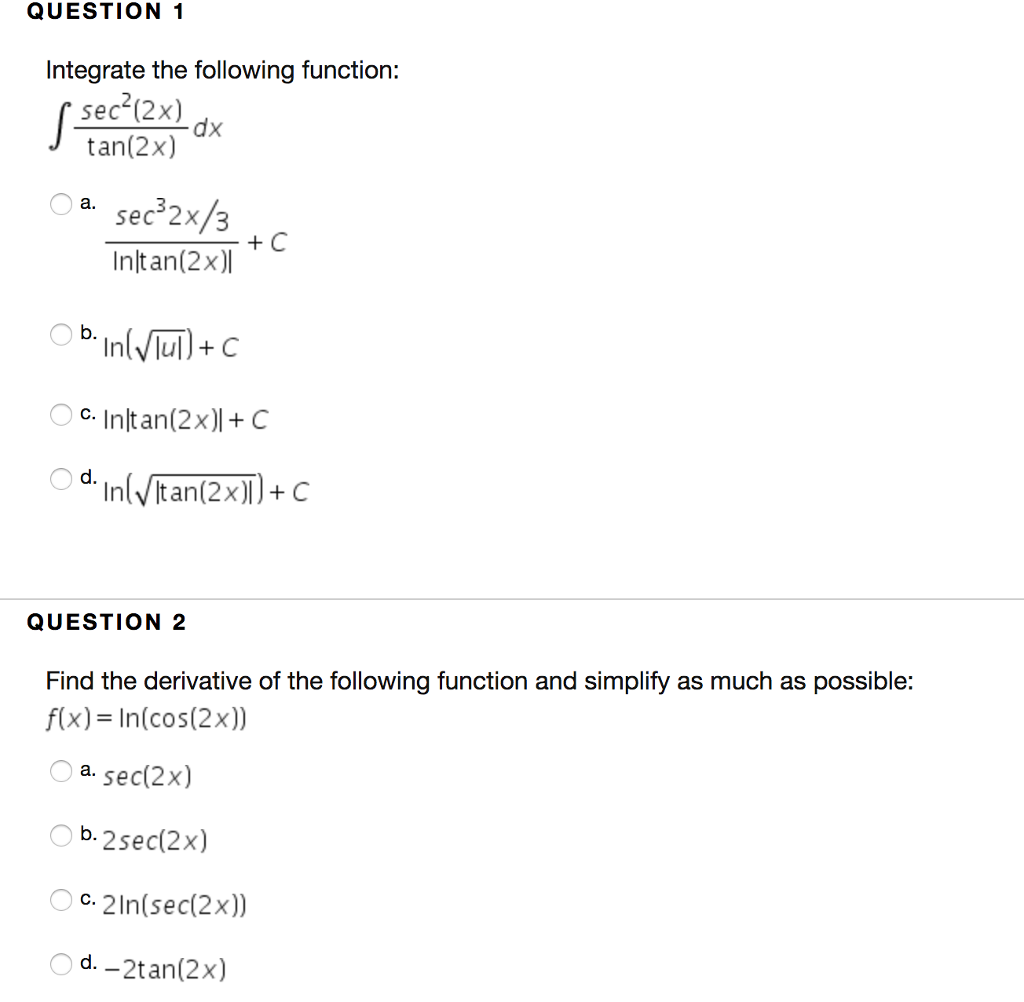



Question 1 Integrate The Following Function Sec 2x Chegg Com
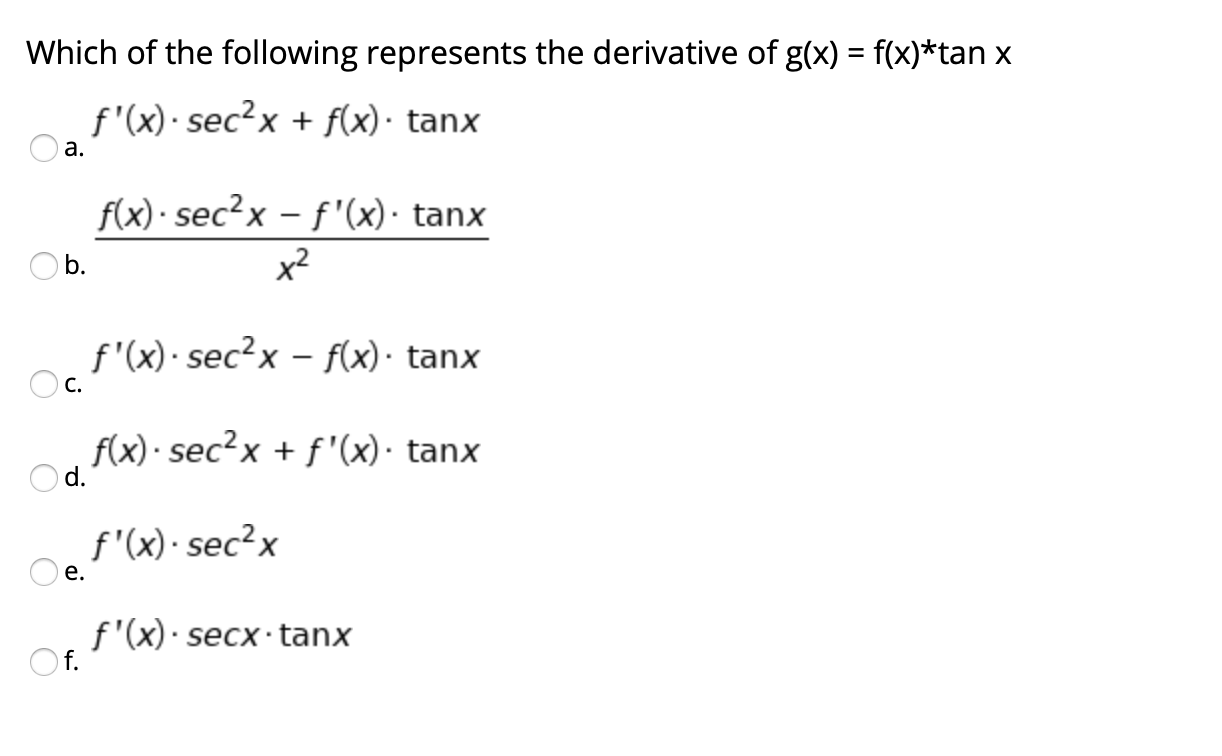



Which Of The Following Represents The Derivative Of Chegg Com




Sample Problems Cos 2 X Tan2 X Tan 2 Csc 2 Tan Sec X Tan X Cos X Sin 4 X Cos 4 X 1 2 Cos 2 X Pdf Free Download




Integration Of Sec 2x Tanx Brainly In




Tan2x Sec2x ただの悪魔の画像



Http Www2 Southeastern Edu Academics Faculty Ereyes 0ch2 Pdf
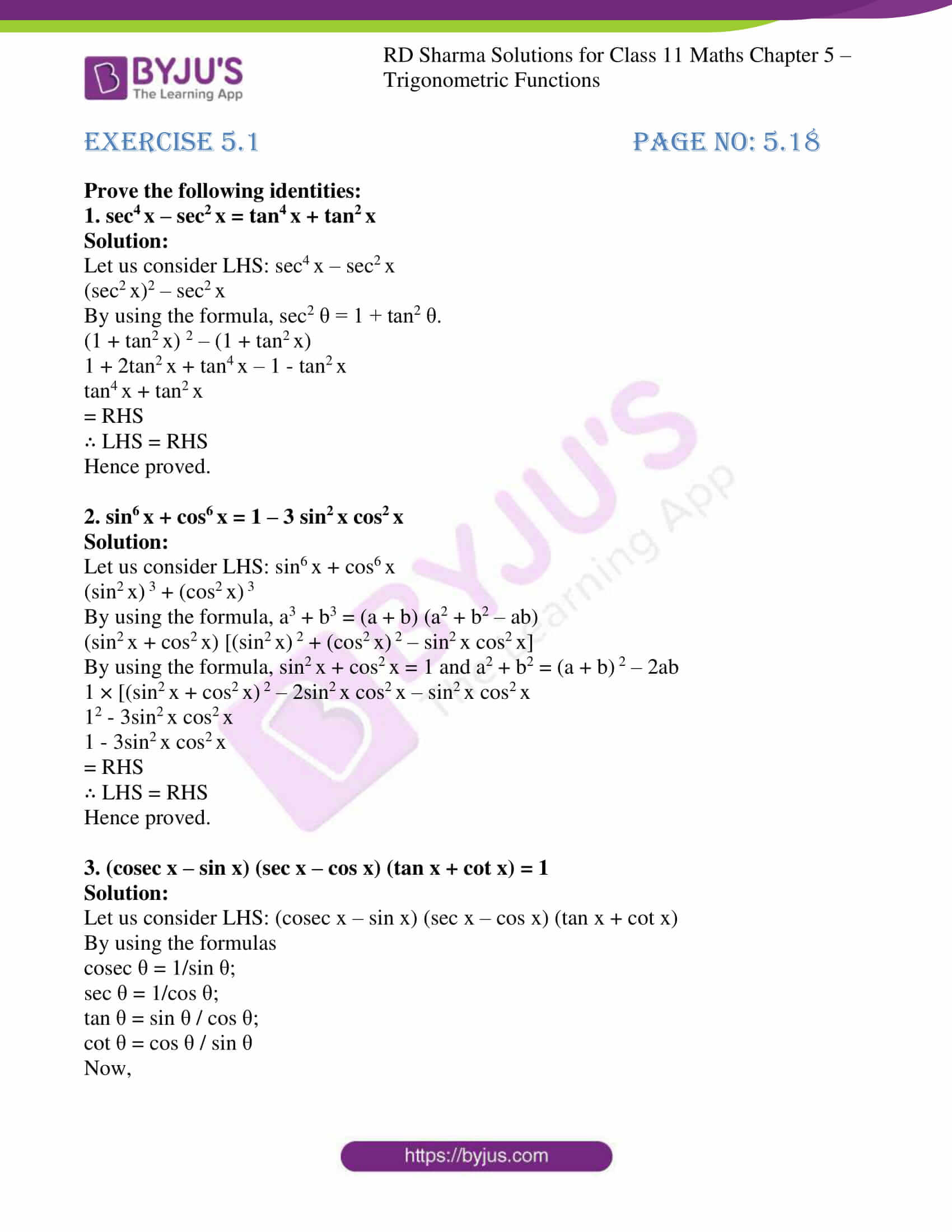



Rd Sharma Solutions For Class 11 Chapter 5 Trigonometric Functions



Www Pdsd Org Cms Lib Pa Centricity Domain 181 Work and solutions to the worksheet on finding derivatives of functions using the chain rule Pdf



2



Www Amherst Edu Media View Original Ma11spring11finalanswers Pdf
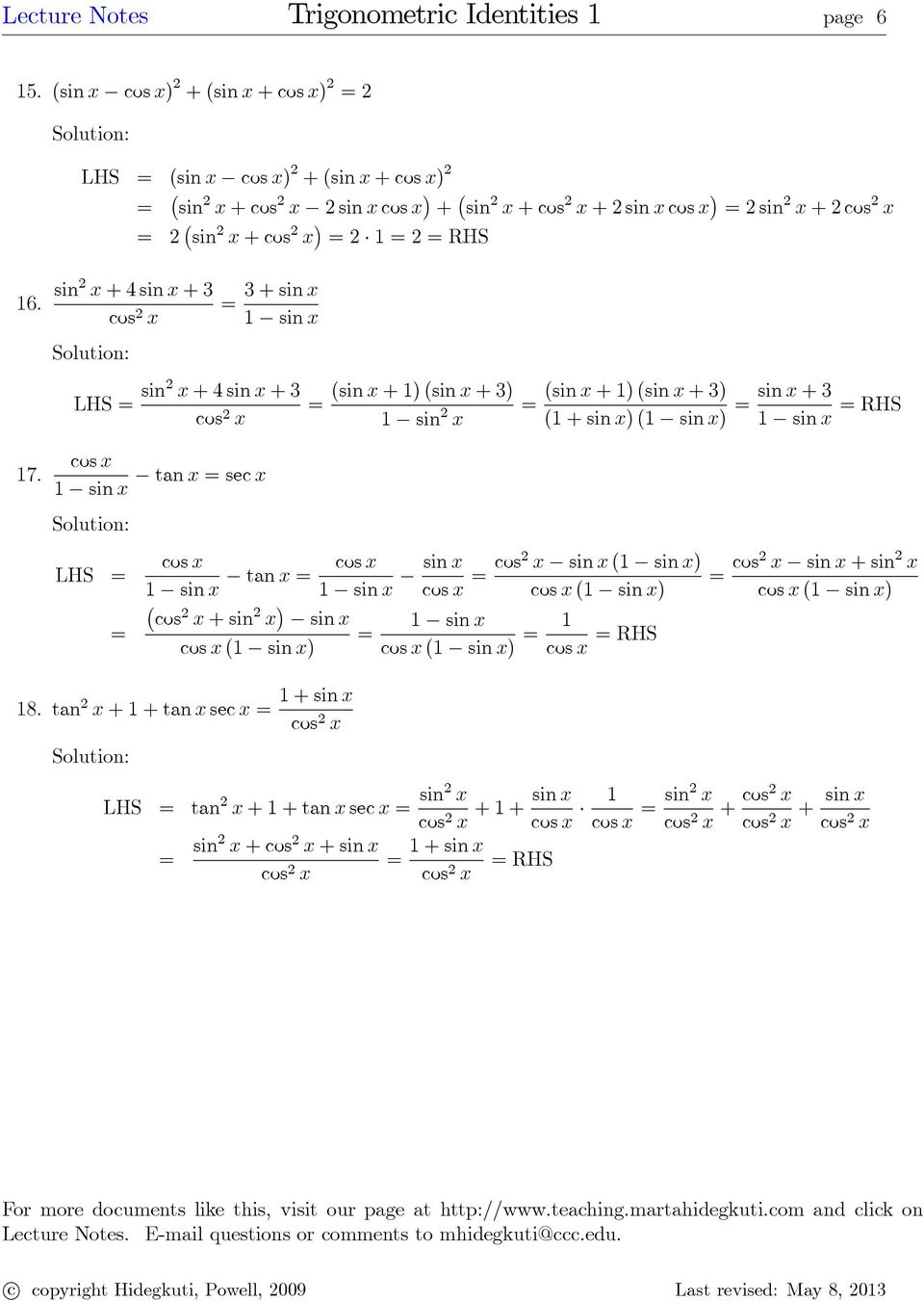



Sample Problems Cos 2 X Tan2 X Tan 2 Csc 2 Tan Sec X Tan X Cos X Sin 4 X Cos 4 X 1 2 Cos 2 X Pdf Free Download



Is This Correct Because My Book Says The Answer Is Tan 2x Sec 2x Secx Calculus




Find The Derivative Of Y Sec Tan X Brainly In
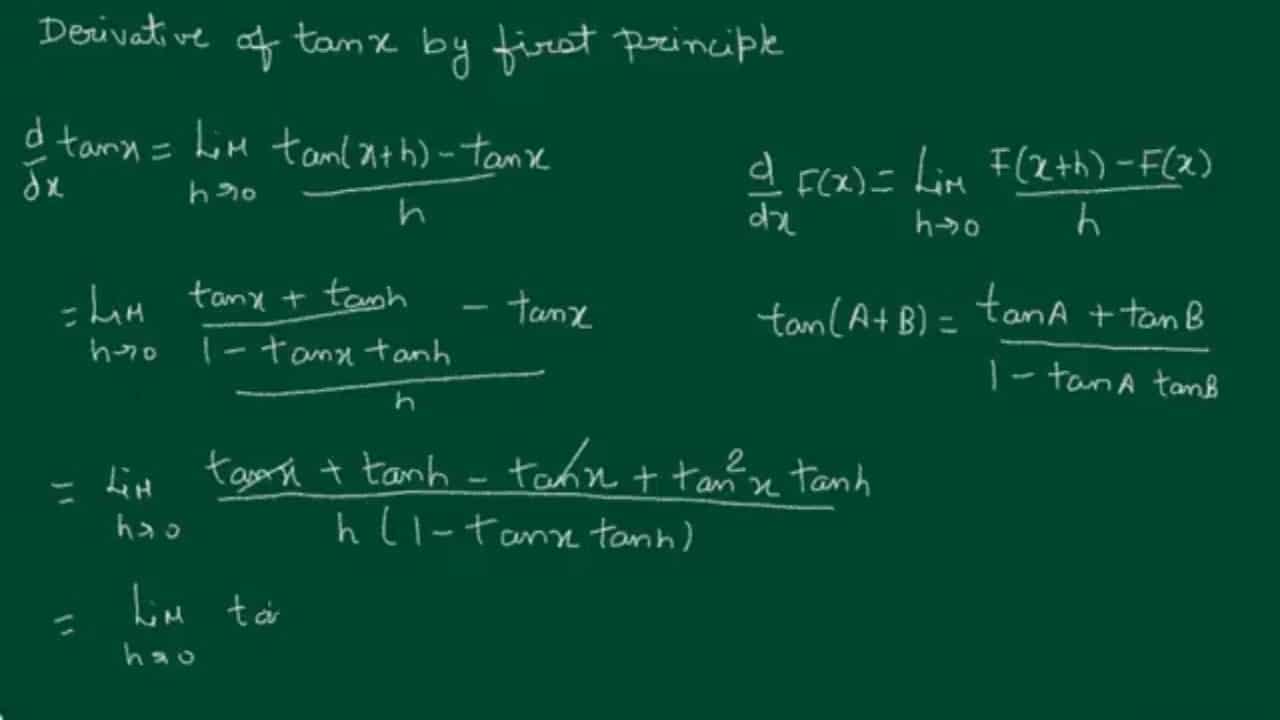



Derivative Of Tangent X Sec X Tan X Longer Free Tutorial Get Education Bee




Use First Principles To Find The Derivative Of F X Sec X Enotes Com
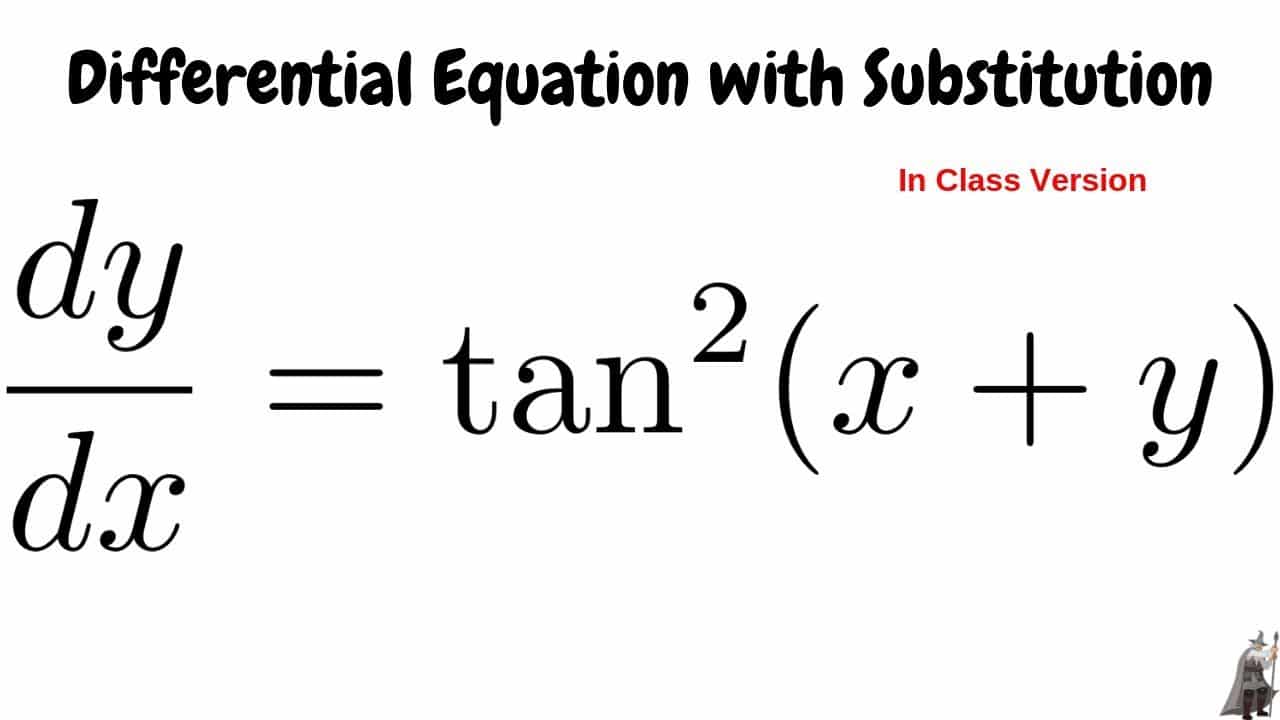



Derivative Of Tangent X Sec X Tan X Longer Free Tutorial Get Education Bee
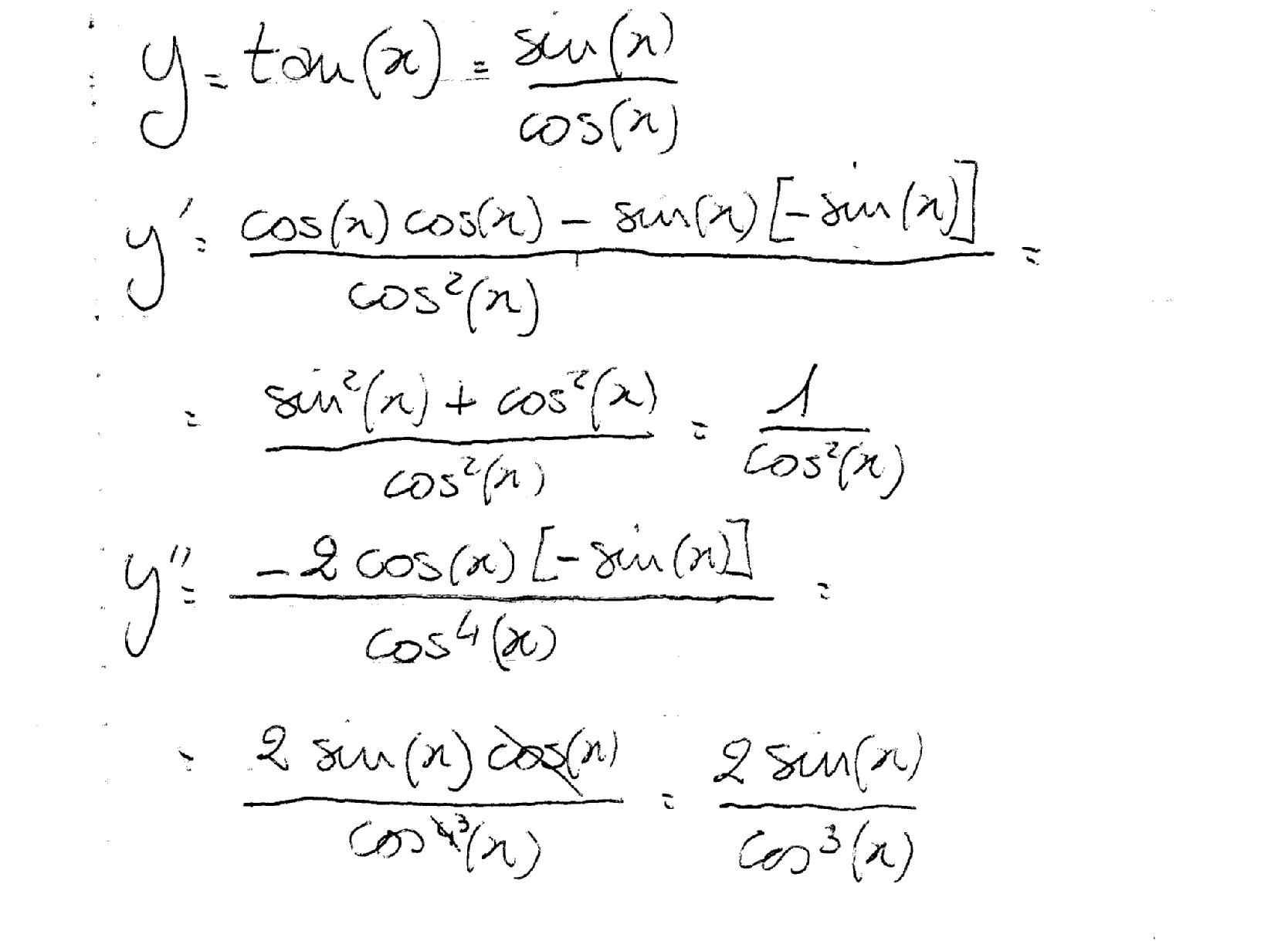



What Is The 2nd Derivative Of Y Tanx Socratic



Www Mvcc Edu Learning Commons Pdf Sp Ma151finalexamreview Pdf




Derivatives Of Tan X And Cot X Video Khan Academy



Http Www Science Marshall Edu Karna Pdfdocfiles Examsingle 229exam2 Pdf



Www Mvcc Edu Learning Commons Pdf Sp Ma151finalexamreview Pdf



Faculty Math Illinois Edu Lfolwa2 Gw Sol Pdf



2
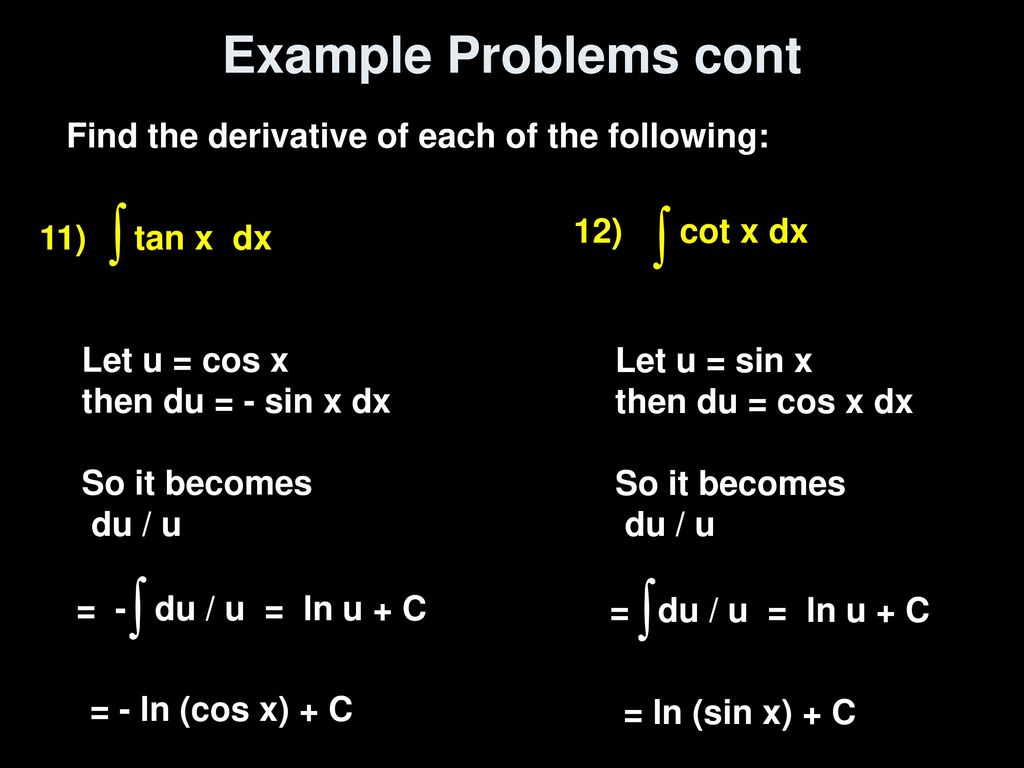



U Substitution Or The Chain Rule Of Integration Ppt Download



What Is The Differentiation Of Math Ln Sec X Math Quora



1




What Is The Integral Of Int Tan 4 X Sec 3 X Socratic




Find Dydx Where Y Sec X Tan X X 2 Y 0




Proof Derivative Of Tanx Sec 2x Youtube



Http Www Lcps Org Cms Lib4 Va Centricity Domain 2 1 2 4 quiz review Pdf



Www Pnw Edu Wp Content Uploads 03 Lecture Notes 14 1 2 Pdf



What Is The Derivative Of Tan 1 Sec X Tan X Quora



Web Auburn Edu Holmerr 1617 Textbook Derivsummary Print Pdf




Derivative Of F X 2x 2ln 2x With Product And Chain Rule Chain Rule Math Videos Derivative




The Derivative Of Tanx Shefalitayal



Http Www2 Gcc Edu Dept Math Faculty Bancrofted Teaching Handouts Differentiation Pdf




Derivative Of Secx Tanx The Ultimate Guide And What Is The Derivative Of Secx



Http Www Science Marshall Edu Karna Pdfdocfiles Examsingle 229exam2 Pdf




Derivative Rules For Trigonometric Functions
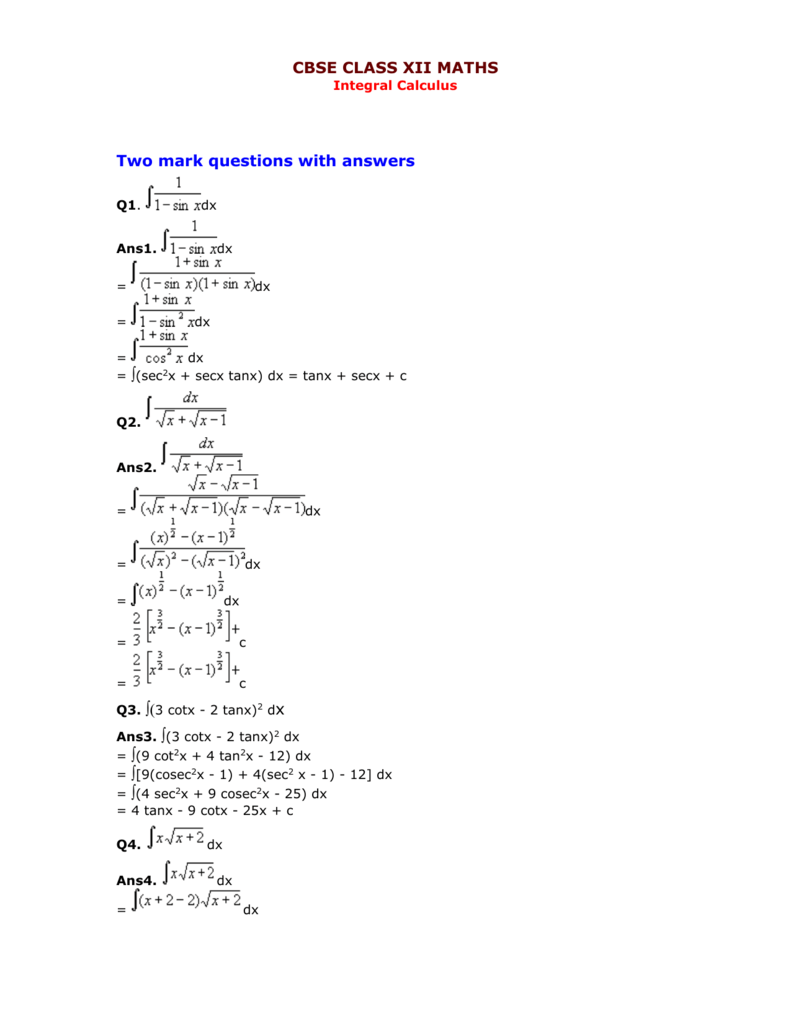



Integral Calculus



2




Evaluate Int Sec 2xtanx Sec 2x Tan 2x Dx



2



Tan 2x Tan 2x




2 S Sec 40 1 Sec X Dx Sec 2 X Sec X Dx Sec 2 X Tan X ſtan X N 2 Sec X Sec X Tanx De
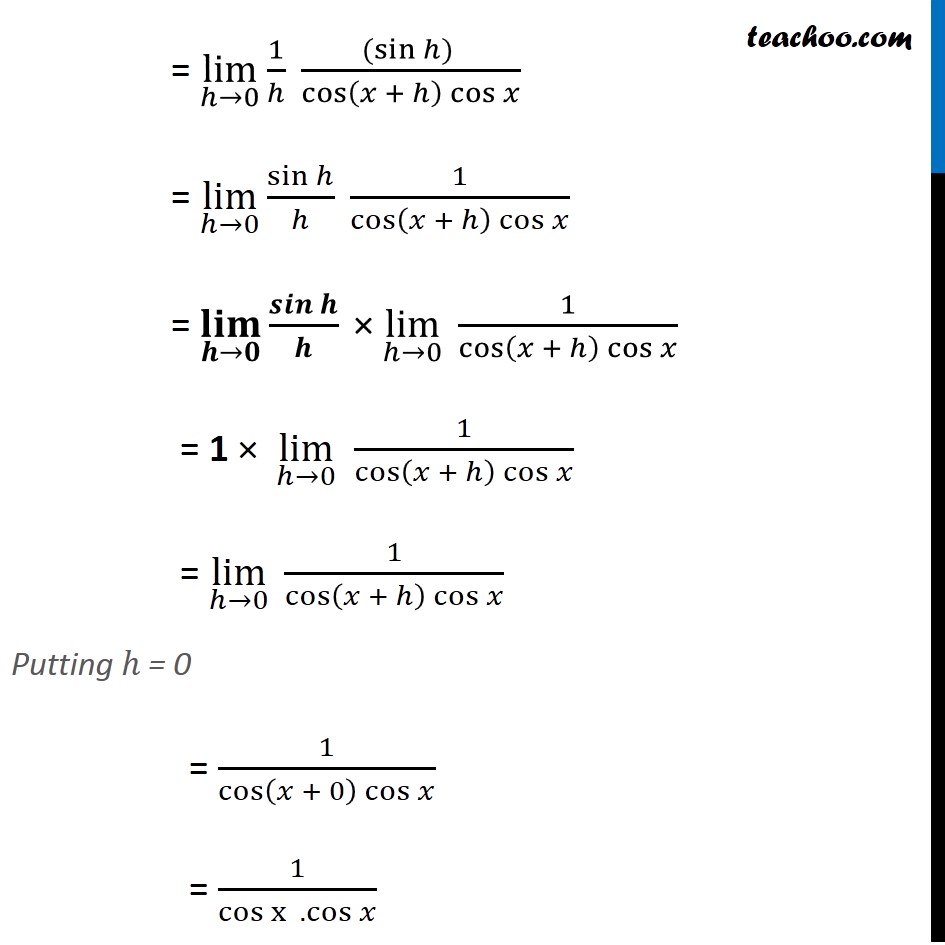



Prove That Derivative Of Tan X Is Sec 2 X By First Principle




Integration Calculus Notes
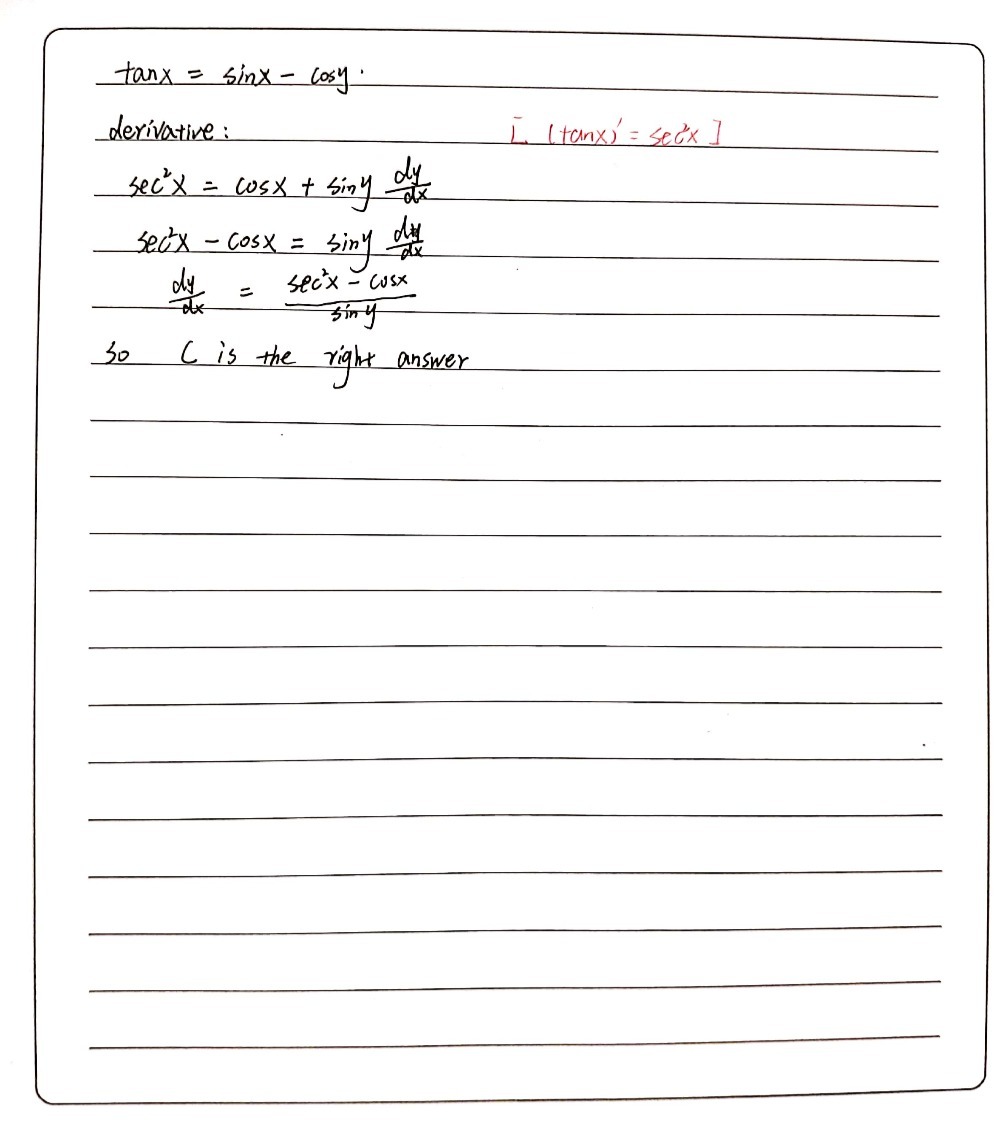



10 What Is The Derivative Of Tan X Sin X Cos Y Gauthmath
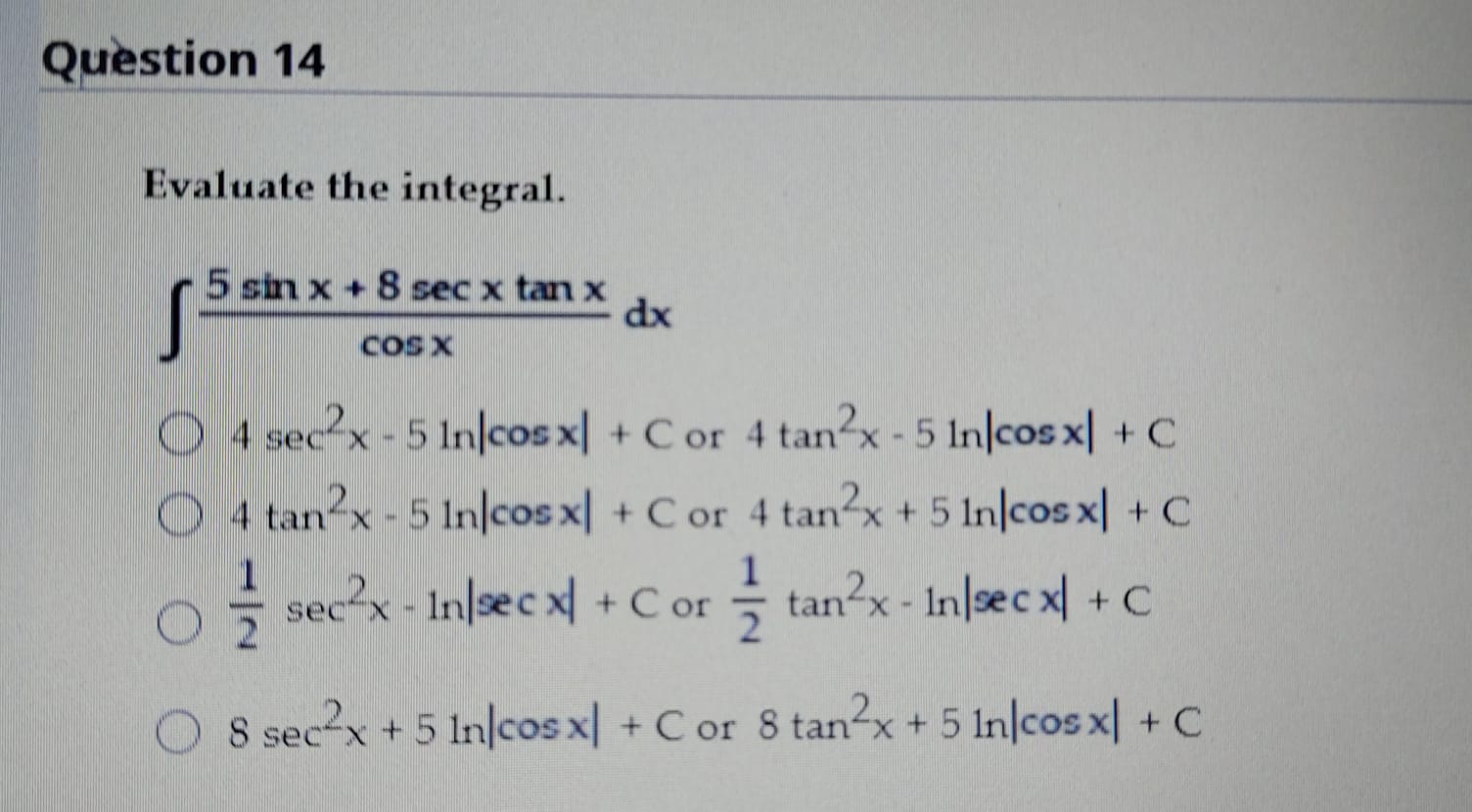



Answered Evaluate The Integral 5 Sin X 8 Sec X Bartleby



Http Www2 Johnabbott Qc Ca Math Dobson Diff Pdf




The Derivative Of Tan X Is Sec 2 X Why Mathematics Stack Exchange




What Is The Derivative Of Sec 2 Tan 1 X With Respect To X
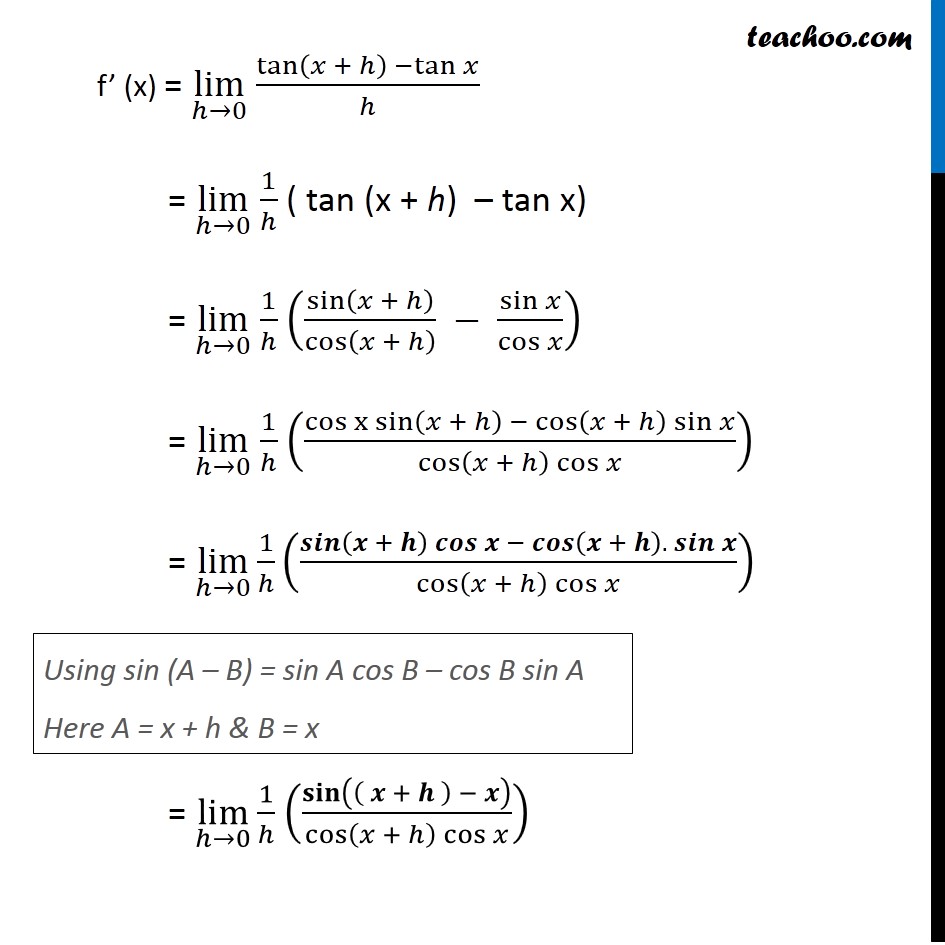



Prove That Derivative Of Tan X Is Sec 2 X By First Principle
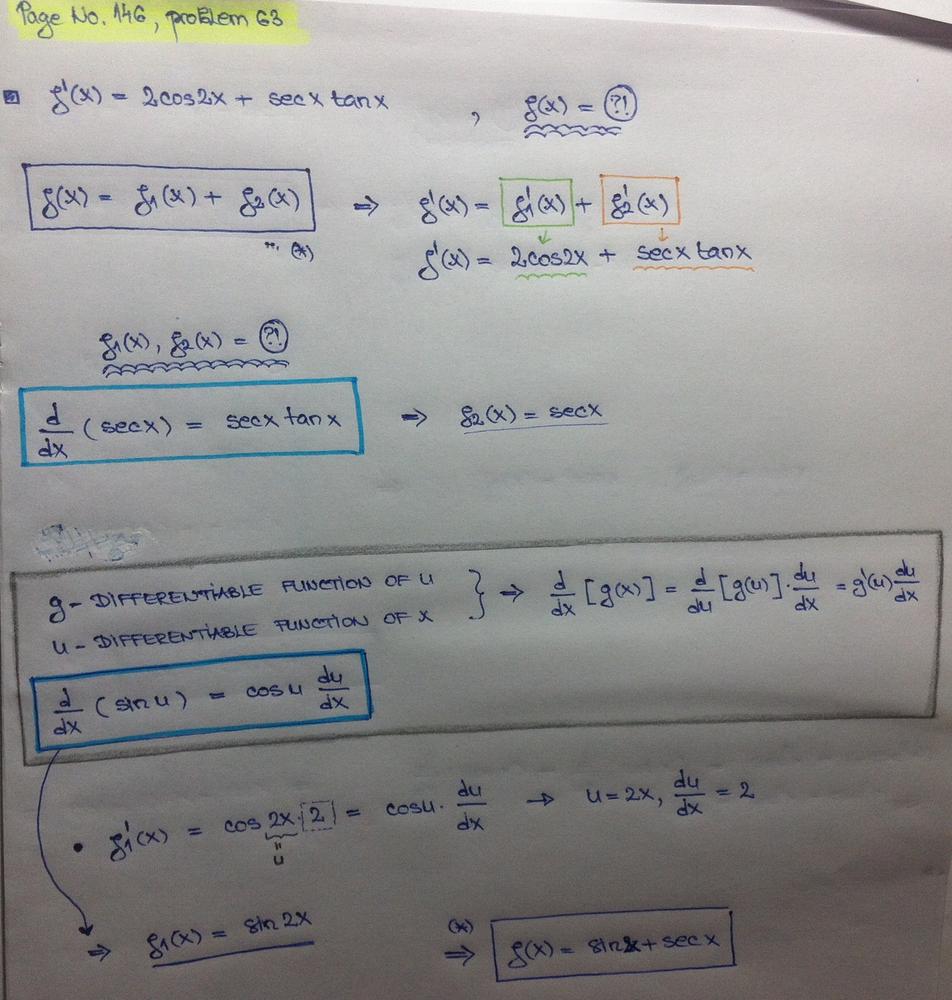



Find A Function F With The Given Derivative Math F X 2 Cos 2x Sec X Tan X Math Homework Help And Answers Slader



0 件のコメント:
コメントを投稿